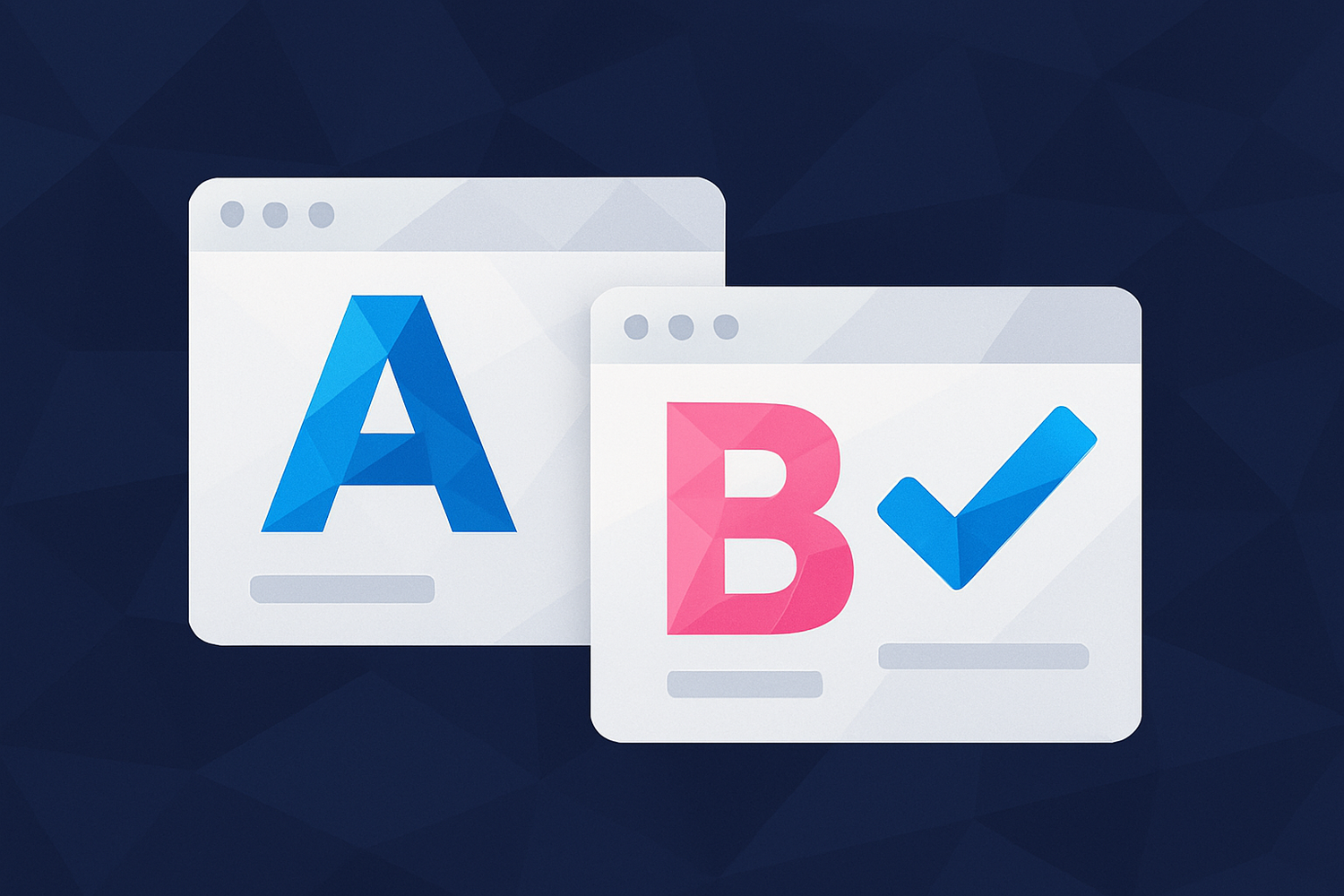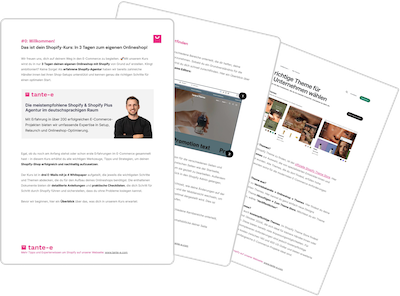Many Shopify merchants are familiar with this situation: They have many ideas for improving their store, but it's often unclear whether these changes will actually lead to better results. This is where A/B testing comes in. Instead of relying on gut feeling or personal preferences, it allows for a structured, data-driven approach to make informed decisions.
At tante-e, we experience in our daily work with e-commerce brands how valuable A/B testing can be for the further development of a Shopify store. We also notice how much potential is wasted when it's not used or is implemented incorrectly.
In this article, we explain exactly which questions you should ask yourself in advance regarding A/B testing and how AEVOR and pinqponq work to further develop their customer experience based on data.

This blog post is based on the knowledge of our expert Esther. She has years of experience in the continuous optimization and development of Shopify stores. In the tante-e podcast, she shares her extensive knowledge of A/B testing ( YouTube / Spotify / Apple Podcasts ), among other things.
- What is A/B testing on Shopify – and why is it useful?
- When is A/B testing worthwhile for Shopify merchants?
- Launching successful A/B tests: Hypothesis, objectives & setup
- The best tools for A/B testing on Shopify
- Practical example: A/B testing with AEVOR and pinqponq
- Our learnings from over 100 Shopify A/B tests
1. What is A/B testing on Shopify – and why is it useful?
1.1. Basics & Goals of A/B Testing for E-Commerce Brands
A/B testing describes the targeted comparison of two variants—for example, product pages, elements on the homepage, or individual functions in the shopping cart. Visitors to the shop are randomly presented with either variant A or variant B. The analysis then determines which version better achieves the defined goal—for example, more sales, higher interaction rates, or fewer abandonments.
1.2. Goals of A/B testing in e-commerce
| Objective | Example |
|---|---|
| Increase conversion rate | Which variant leads to more completed purchases? |
| Better understand user behavior | Is a new feature noticed and used? |
| Optimize the customer journey | Is the path to the desired action in the shop shortened? |
| Systematically test hypotheses | Does a particular section really lead to more sales? |
| Minimize risk when making changes | Prevents new elements from unintentionally degrading performance. |
For example, suppose a store observes that customers rarely buy more than one product per order. The hypothesis is that a cross-selling section in the shopping cart could lead to higher shopping cart values. Instead of implementing this assumption directly, however, it is tested in an A/B test. The assumption is then confirmed or potentially revealed to be a hindrance. This not only provides clarity but also avoids unintentionally losing conversions due to well-intentioned features.
How do you design the perfect product page on Shopify ? Find all the tips and examples in our guide.
1.3. Advantages of data-driven optimization
- Less gut feeling, more evidence: Decisions are not based on assumptions, but on actual user behavior.
- Better understanding of the target audience: Which information is relevant? What is being overlooked? A/B testing provides clear clues.
- More security when making changes: Adjustments in the shop are carried out in a controlled manner – with low risk.
- Long-term insight: Beyond individual tests, the strategic understanding of UX, content and communication grows.
2. When is A/B testing worthwhile for Shopify merchants?
Not every Shopify store is automatically suitable for A/B testing. Before testing can begin, our expert Esther recommends a sufficient database. This is the only way to evaluate results with statistical significance—that is, to make reliable statements about whether one variant actually performs better.
2.1. When does A/B testing make sense?
| criterion | Recommendation |
|---|---|
| Conversions per month | At least 500 conversions as a guideline |
| Traffic on the test page | The tested elements should be clearly visible and frequently visited |
| Resources in the team | Capacity for conception, implementation and evaluation available |
| Technical basics | Tracking and analytics are well set up |
| Clear goal & hypothesis | Without a concrete test target, ineffective implementation is threatened |
Especially in smaller teams or with lower traffic, A/B testing can quickly become a time-consuming and financial challenge. The testing tool used often costs money on a monthly basis, regardless of how many tests are actually conducted. Those who test infrequently rarely reap the full benefits.
2.3. Alternatives & recommendations for smaller shops
If the requirements for real A/B testing are not (yet) met, Esther recommends other ways to optimize your own shop based on data:
- Heatmaps & session recordings (e.g. with Hotjar or Clarity): Show how users actually move through the shop.
- Web analysis with Google Analytics or Matomo: Provides information about entry pages, abandonment, and conversion funnels.
- Feedback from customer service: This often reveals recurring hurdles or misunderstandings in the shop.
- Internal tests & micro-experiments: Deliberately introduce small changes and observe their effects – even without a direct comparison group.
Esther sums it up in the podcast : A systematic look at visitor behavior is often enough to get started. If you observe which elements are clicked – or overlooked – you can implement initial optimizations directly and without the need for testing. A/B testing is worthwhile if you want to develop a roadmap of concrete hypotheses and test them regularly. This not only leads to better decisions, but also valuable insights into the target audience.
3. Launch successful A/B tests: Hypothesis, objective & setup
An A/B test stands or falls with its preparation. What at first glance appears to be a technical or design-related task is actually a strategic one: Only those who know what they are testing, why they are testing it, and how they are evaluating it can achieve reliable results. Experience shows: A well-thought-out A/B test not only saves time and money but also delivers real learnings.
3.1. Three key questions before every test
-
What is my hypothesis?
→ Which assumption do I want to test? -
What is my goal?
→ Which metric determines success or failure? -
Who does the test affect?
→ Which users should see the test – and where?
3.2. Setup elements that should be defined before starting
| element | Meaning |
|---|---|
| Target metric | Conversion rate, click rate, dwell time, add-to-cart etc. |
| Test target group | e.g. only mobile users, new visitors or returning customers |
| Test page | Home page, product page, shopping cart – or a specific template variant |
| Trigger conditions | e.g. visibility of an element, scroll depth or specific funnel step |
| Test runtime | Recommended: at least 2–4 weeks, depending on traffic |
One mistake we often see is testing multiple changes simultaneously. For example, if you introduce ten new sections on a product page and test them as "Variant B," it's difficult to say afterwards which change influenced the results. Esther therefore recommends only changing one variable per test – and ideally, only running one active test per page to avoid mutual interference.
Experience shows that many tests fail not due to poor implementation, but due to insufficient runtime. Even with high traffic, it can take time for a result to become statistically reliable. Seasonal effects or sales phases should also be taken into account: Those who test during a sales event will get different results than during normal operations. Therefore, it is important to choose the runtime and timing carefully.
4. The best tools for A/B testing on Shopify
Shopify doesn't offer a native way to implement A/B testing directly within the system. Therefore, anyone who wants to conduct in-depth testing needs an external A/B testing tool. These can be integrated via snippets or Google Tag Manager and allow you to play out targeted variants, capture user behavior, and make valid decisions based on data.
At tante-e, we regularly work with various solutions—most frequently ABlyft and varify.io . Both tools integrate well with Shopify, but differ fundamentally in their methodology, feature set, and pricing model.
4.1. Tool comparison: ABlyft vs. varify.io
| feature | ABlyft | varify.io |
|---|---|---|
| Tracking basis | Own tracking system with own database | Uses Google Analytics as a basis |
| Evaluation | Only possible on previously defined targets | Goals can also be evaluated retrospectively |
| Technical depth | Ideal for developers & complex setups | Beginner-friendly, quick start possible |
| Price structure | Higher priced, worthwhile with regular use | Starting from about 120 €/month |
| Suitable for … | Scaling brands with testing roadmap | Small to medium-sized shops that want to gain initial experience |
4.2. When which tool is useful
ABlyft is particularly suitable for Shopify brands with a clear testing strategy, technical expertise, and high test volumes. Its independence from the rest of the tracking setup is an advantage when data protection, data quality, or more complex requirements are important.
varify.io is a powerful solution for getting started. The integration with Google Analytics eliminates additional tracking effort. Especially for small and medium-sized teams with limited resources, the tool is an easy way to set up initial A/B tests – without major hurdles.
Read more in the tante-e blog: These top Shopify apps every retailer should know
5. Practical example: A/B testing with AEVOR and pinqponq
What works in theory only proves itself in practice. A good example of this are the two brands AEVOR and pinqponq – two e-commerce brands from the same business environment, with comparable products (backpacks, bags, apparel) and a similar tech stack on Shopify. However, their A/B tests show that even under seemingly identical conditions, user behavior can vary significantly.

For both shops, tante-e is supporting the testing roadmap in partnership – from conception and UX design to technical implementation and evaluation. Testing is carried out with ABlyft , supplemented by Google Tag Manager and tools like Hotjar for qualitative user understanding.
5.1. Procedure: This is how A/B testing works at AEVOR & pinqponq
-
Collect ideas & hypotheses
e.g. based on user behavior, analyses or target group feedback -
Conception & UX development
Targeted variant development with a focus on clarity and user guidance -
Technical implementation & QA
Implementation directly in the tool or via code -
Test run & monitoring
Duration usually 2–4 weeks with regular review -
Evaluation & derivation of measures
Segment analyses, validation of the hypothesis and, if necessary, follow-up tests
5.2. Example Tests & Learnings
| Test element | Result at AEVOR | Result at pinqponq |
|---|---|---|
| Color representation in the product overview | Thumbnails with mini image previews increased interaction & conversion | Same result – visual orientation clearly has the advantage |
| Review display in the category page | No significant impact | Clearly positive effect on conversion |
| Moody introductory text on product page | Unexpectedly good performance – despite few facts | Similar tendency, users react to emotional texts |
| Size Finder at Apparel | No significant difference in conversion | Here too: no noticeable effect |
“The same test can lead to completely different results for two shops with a similar target audience – depending on product depth, user expectations, or brand tone.”
– Esther, Shop Optimization at tante-e
- Target group logic is not transferable: Even similar products may function differently.
- Visual orientation often has a stronger effect than expected: Especially with variants (colors, styles), images help more than technical selectors.
- Emotion doesn’t always beat reason: explanatory, atmospheric texts can also perform well – if they fit the product.
- Not every “best practice” is universal: data provides context – and sometimes surprising results.
6. Our learnings from over 100 Shopify A/B tests
After conducting numerous A/B tests on Shopify projects, one thing is clear to us: success doesn't happen by chance. The tests that produce relevant results always have one thing in common: thoughtful preparation.
The real work happens before the test. Knowing what you want to test, why you want to test it, and how to evaluate the results not only saves time but also creates real added value.
6.1. Success factors for meaningful A/B tests
| factor | Why it is crucial |
|---|---|
| Clear hypothesis | Only those who test a concrete assumption can derive reliable learning |
| Targeted setup | Who sees the test? When is it played? Where is it triggered? |
| Only one change per test | Prevents falsifications and makes cause and effect transparent |
| Sufficient runtime & patience | Statistical significance takes time – especially at deeper funnel steps |
| Segmented evaluation | Differences by device type, target audience or context often provide additional insights |
6.2. What happens after the test?
An A/B test doesn't end with the final evaluation. On the contrary, it's often the starting point for the next optimization:
- Implement a successful variant
- Derive a hypothesis for a follow-up experiment
- Transfer findings to other areas (e.g. marketing or product development)
- Document and share knowledge internally


